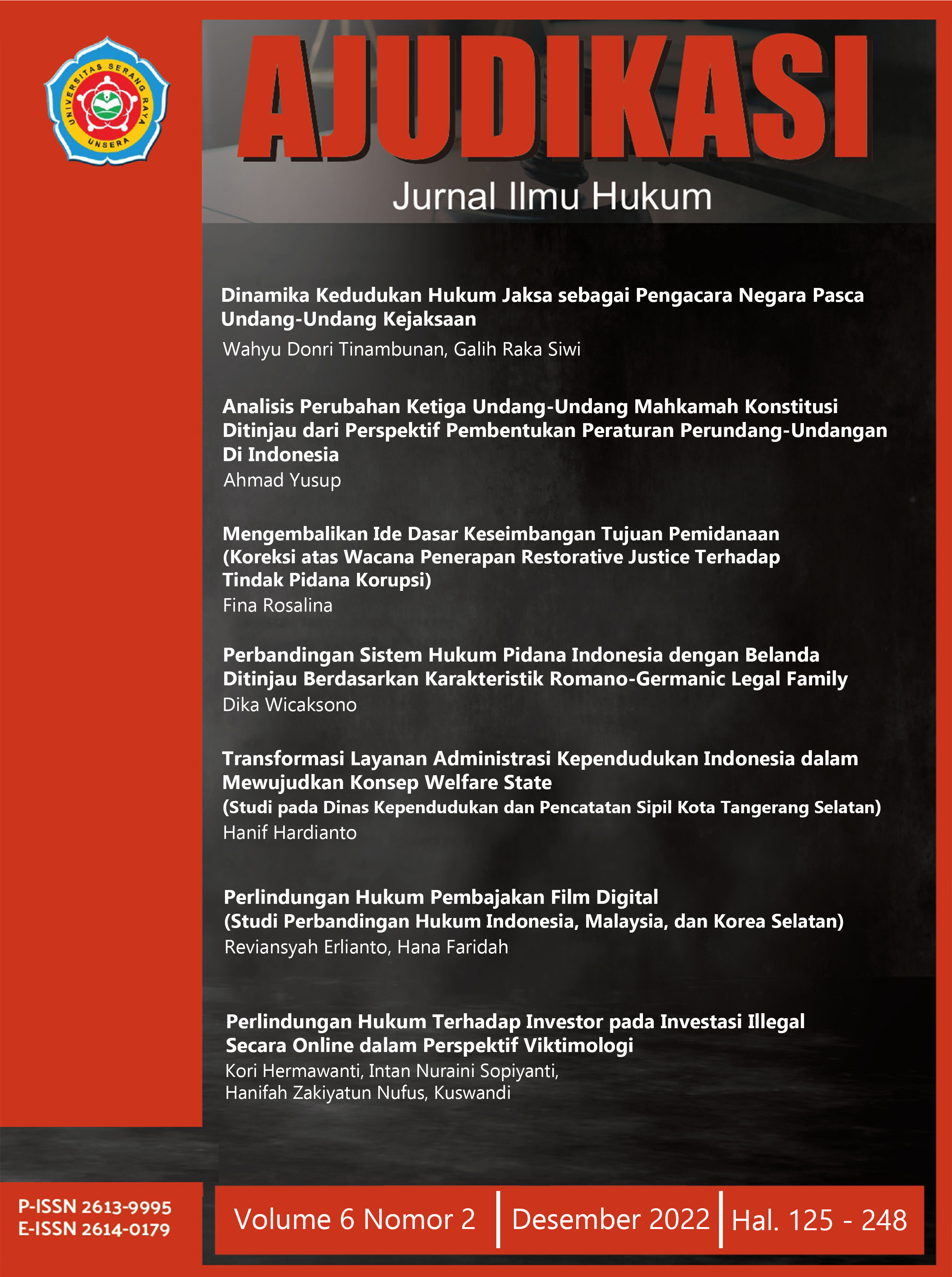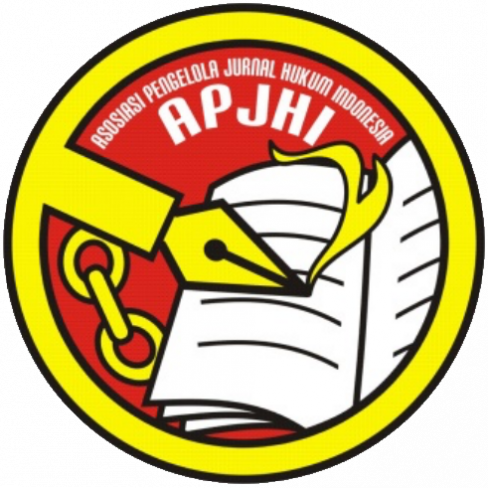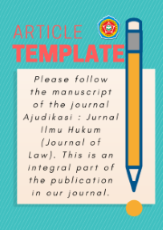Perlindungan Hukum Pembajakan Film Digital
(Studi Perbandingan Hukum Indonesia, Malaysia, dan Korea Selatan)
DOI:
https://doi.org/10.30656/ajudikasi.v6i2.5469Keywords:
Film, Piracy, Comparative, Law, CopyrightAbstract
Cinematography is one of the copyrighted works that are included in the scope of works that are protected in the Copyright Law, therefore the state needs to protect film works, especially domestic films. In the case of rampant acts of digital film piracy, resulting in moral and economic losses to the creators or filmmakers, of course the need for legal protection by the state for them. The purpose of this study is to understand the existence of the state in copyright protection related to the phenomenon of film piracy, and to compare regulations related to copyright between Indonesia, Malaysia, and South Korea. The author conducts legal comparisons and uses normative legal research methods in the form of secondary data that are combined through a literature study. The results obtained are that the three countries through their respective regulations regulate and protect all forms of creation produced through IPR. And the need for the government's role in educating the public in appreciating copyright and copyrighted works.
Downloads
References
Aan Priyatna. “Penegakan Hukum Terhadap Pelanggaran Hak Cipta Dalam Pembuatan E-Book.†Semarang, 2016.
Hery Firmansyah, S. H. Perlindungan Hukum Terhadap Merek. Yogyakarta: MediaPressindo, 2013.
Santoso, B. HKI Hak Kekayaan Intelektual. Semarang: Penerbit Pustaka Magister, 2011.
2. JURNAL
Abidin, D. Z. “Kejahatan Dalam Teknologi Informasi Dan Komunikasi.†Jurnal Processor 10, no. 2 (2017): 509–16.
Alam, M. Z. “Perbandingan Perlindungan Sarana Kontrol Teknologi Atas Ciptaan Menurut Ketentuan Hak Cipta Di Indonesia Dan Amerika Serikat.†Legal Spirit 2, no. 1 (2018).
Angela, M., and S. Winduwati. “Representasi Kemiskinan Dalam Film Korea Selatan (Analisis Semiotika Model Saussure Pada Film Parasite).†Koneksi 3, no. 2 (2019): 478–84.
Ardiyanti, H. “PERFILMAN INDONESIA: PERKEMBANGAN DAN KEBIJAKAN, SEBUAH TELAAH DARI PERSPEKTIF INDUSTRI BUDAYA (CINEMA IN INDONESIA: HISTORY AND GOVERMENT REGULATION, A CULTURAL INDUSTRY PERSPECTIVE).†Kajian 22, no. 2 (2020): 163–79.
Benuf, K., and M. Azhar. “Metodologi Penelitian Hukum Sebagai Instrumen Mengurai Permasalahan Hukum Kontemporer.†Gema Keadilan 6, no. 2 (2020): 20–33.
Desmayanti, R. “UNDANG-UNDANG HAK CIPTA INDONESIA DAN UNDANG-UNDANG HAK CIPTA MALAYSIA: PERLINDUNGAN DAN PENERAPAN (SEBUAH PERBANDINGAN).†ADIL: Jurnal Hukum 4, no. 2 (2013): 371–95.
Hsb, M. O. “HAM DAN KEBEBASAN BERPENDAPAT DALAM UUD 1945.†AL WASATH Jurnal Ilmu Hukum 2, no. 1 (2021): 29–40.
Mamudji, S. “Mediasi Sebagai Alternatif Penyelesaian Sengketa Di Luar Pengadilan.†Jurnal Hukum & Pembangunan 34, no. 3 (2017): 194–209.
Mudjiono, Y. “Kajian Semiotika Dalam Film.†Jurnal Ilmu Komunikasi 1, no. 1 (2020): 125–38.
Ningsih, A. S., and B. H. Maharani. “Penegakan Hukum Hak Cipta Terhadap Pembajakan Film Secara Daring.†. . Jurnal Meta-Yuridis 2, no. 1 (2019).
Puspasari, C., Suryani, A., and R. L. MBP. “Pengaruh Globalisasi Film Indonesia: Interpretasi Budaya Dalam Film Nagabonar Dan Nagabonar Jadi 2.†COVERAGE 8, no. 1 (2017): 1–12.
Raharja, G. G. G. “PENERAPAN HUKUM TERHADAP PELANGGARAN HAK CIPTA DI BIDANG PEMBAJAKAN FILM.†Jurnal Meta-Yuridis 3, no. 2 (2020).
Ruhtiani, M. “Perbandingan Perlindungan Hukum Pada Hak Cipta Antara Indonesia Dan Korea Selatan.†Jurnal Hukum 1, no. 1 (2018): 25–43.
Sardjono, A. Hak Cipta Dalam Desain Grafis. Yellow Dot Pub, 2008.
Utama, S. P. “ANALISIS FAKTOR YANG MEMPENGARUHI MINAT KONSUMEN DALAM MEMBELI FILM BAJAKAN.†Media Mahardhika 18, no. 1 (2019): 24–31.
Vernando, W., Kurniawan, V. K., Ellysinta, and J. Lim. “Pengaruh Illegal Movie Streaming Terhadap Popularitas Film Bagi Mahasiswa. Jurnal Teknologi Informasi.†Jurnal Teknologi Informasi 6, no. 1 (2020): 35–42.
3. PERATURAN PERUNDANG-UNDANGAN
Act 332-Copyright Act of Malaysia 1987
Article 4 Act No. 14634-Copyright Act of South Korea.
Section 10A Act 332-Copyright Act of Malaysia 1987.
Undang-Undang Dasar Republik Indonesia 1945.
Undang-Undang Nomor 33 Tahun 2009
Undang-Undang Nomor 28 Tahun 2014
4. WEBSITE
Tan, Janice. “Malaysian Media and Entertainment Industry Claims RM3bn Lost Annually Due to Piracy.†Avertisting Marketing, 2021. https://www.marketing-interactive.com/malaysian-media-and-entertainment-industry-claims-rm3bn-lost-annually-due-to-piracy.
WIPO. “Copyright.†World Intelektual Property Organization, n.d. https://www.wipo.int/copyright/en/.
Downloads
Published
Issue
Section
License
Authors who publish with this journal agree to the following terms:
Authors retain copyright and grant the journal right of first publication with the work simultaneously licensed under a Creative Commons Attribution License that allows others to share the work with an acknowledgment of the work's authorship and initial publication in this journal.
Authors can enter into separate, additional contractual arrangements for the non-exclusive distribution of the journal's published version of the work (e.g., post it to an institutional repository or publish it in a book) with an acknowledgment of its initial publication in this journal.
Authors are permitted and encouraged to post their work online (e.g., in institutional repositories or on their website) before and during the submission process, as it can lead to productive exchanges and earlier and greater citation of published work.
All articles in Ajudikasi : Jurnal Ilmu Hukum can be disseminated provided they include the identity of the article and the source of the article (Ajudikasi : Jurnal Ilmu Hukum). The publisher is not responsible for the contents of the article. The content of the article is the sole responsibility of the author
Ajudikasi : Jurnal Ilmu Hukum is lincensed under a Creative Commons Attribution-ShareAlike 4.0 International License.










1.png)
.png)
.png)





.png)
.png)
.png)
.png)





.png)







